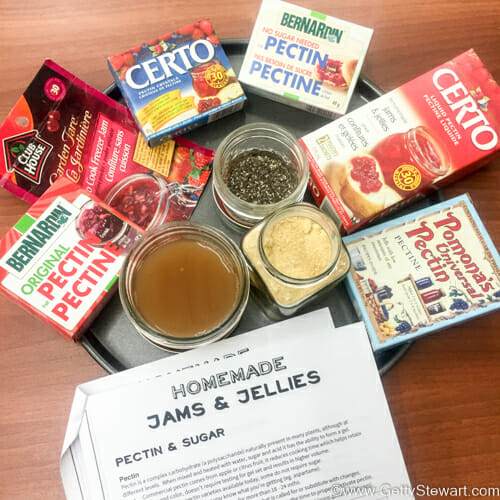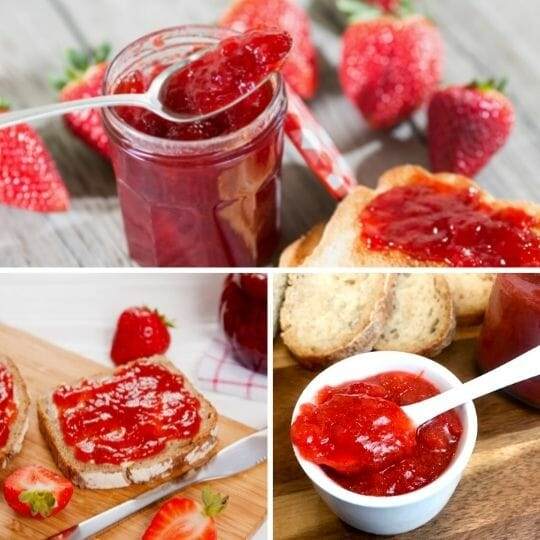What to Do With Runny Jam and Jelly
Aw, snap, don’t you just hate when your jams and jellies turn out runny?! It happens. Here are some thoughts on what happened, how to prevent it and what to do about it now.

Also Read: Three Types of Strawberry Jam Recipes, Types of Pectin, How to Make Jams and Jellies – The Basics
It happens to all of us!
Perhaps it’s comforting to know that it happens to all of us at one time or another. Sometimes it’s easy to back track and discover the problem – like the time I retraced my steps to the recycling bin to check the Best Before Date on the pectin box – it was 12 months past its Best Before Date! Yes, the Best Before Date on pectin matters!
Sometimes, it’s impossible to know what exactly happened. But here are some possible causes for soft, liquidy or runny or jam and jelly.
What Causes Runny Jam or Jelly

We know that in order to get a good set we need a combination of heat, liquid, sugar, pectin and acid. The pectin can be naturally occurring in the fruit we’re using or it can come from added pectin we buy in the store. Check out this Pectin Chart to see the large variety of pectin we can use.
Recipes tell you the type of pectin to use and the correct ratios of fruit/liquid, acid and sugar. They will also provide general recommendations for how long to cook the jam or jelly. To get the promised results – follow the instructions and ingredient list carefully. Usually, when using store bought pectin and you follow the instructions, results are very predictable and testing for the gel set is often not required. However, if you want a good indicator of whether or not your jam or jelly will set – doing the gel set test is a good idea.
Jams or jellies don’t set when any of the elements or ratios are out of sync. It can be related to the amount of acid, sugar, pectin, liquid or heat. The fruit itself is also a highly variable factor as the amount of naturally occurring acid and pectin will vary with every batch depending on growth conditions, sun, rain, variety, ripeness, etc. It is one of the elements we have the least amount of control over.
With those general explanations here’s a chart of potential causes for runny jam and jelly and how to try to prevent it.

What to Do With Runny Jams & Jellies
If you can figure out the cause – great, you can make sure not to repeat the issue next time. But what are you going to do with the runny jam or jelly? Option 1 – Use as Syrup or for a Beverage Mix or Option 2 Reprocess
Option 1 – Enjoy Your Syrup Just As it Is
Embrace the sweet fruity liquid as syrup. Pour it over pancakes or mix it with club soda or sparkling water or maybe even a little gin, vodka or rum.
I’ve given my “syrup” as gifts with a tag on how to make a Fruity Martini. Nobody needs to know this amazing syrup was an accident!
Fruity Martini Mix
To enjoy this homemade martini mix, combine 1 oz of syrup, 1 oz vodka, 1/2 oz orange liqueur, 1/2 oz dry vermouth & 1 oz orange juice. Put in shaker with ice, strain into martini glass and enjoy!
Helpful Tips & Reminders when Re-Processing Jams & Jellies
- WAIT! – Give your jams and especially your jellies enough time to know that they haven’t set. Sometimes it can take 24 or 48 hours – sometimes it can take a couple of weeks! Yes, weeks! I have noticed this is especially true with jellies – make sure you give it enough time.
- Reprocess as if It’s a New Batch – Follow the same safe canning practices – wash your jars, use new lids and use a hot water bath process to finish the deal. If you sterilize the jars before filling, your processing time is less than if you don’t.
- Work in Small Batches – Re-process 4-6 cups at a time for best results. Boiling times will change if the volume of jelly/juice differs and most recipes are written for 4-6 cups of liquid/fruit.
Option 2 – Reprocess Your Jam/Jelly
Here are 4 ways to re-process jams and jellies depending on the type of pectin you used. Ideally, you would use the same type of pectin when reprocessing. This info has been gathered from the National Center for Home Food Preservation and Ball Mason Help Line .
To Remake With Regular Powdered Pectin
For each quart (4 cups) of jelly, mix ¼ cup sugar, ½ cup water, 2 tablespoons bottled lemon juice, and 4 teaspoons powdered pectin. Bring to a boil while stirring. Add jelly and bring to a rolling boil over high heat, stirring constantly. Boil hard ½ minute. Remove from heat, quickly skim foam off jelly, and fill sterile jars, leaving ¼-inch headspace. Adjust new lids and process half pint or pint jars for 5 minutes.
To Remake with Ball Low or No-Sugar Needed Pectin
For each quart (4 cups) of jelly, mix 4 tsp Ball RealFruit Low or No-sugar Needed Pectin with 1/4 cup water. Bring to a boil while stirring. Add jelly and bring to a rolling boil over high heat, stirring constantly. Boil hard ½ minute. Remove from heat, skim foam off jelly, and fill sterilized jars, leaving ¼-inch headspace. Adjust new lids and process half pint or pint jars for 5 minutes. (Process for 10 minutes if jars aren’t sterilized).
To Remake With Liquid Pectin
For each quart (4 cups) of jelly, measure ¾ cup sugar, 2 tablespoons bottled lemon juice, and 2 tablespoons liquid pectin. Bring jelly only to boil over high heat, while stirring. Remove from heat and quickly add the sugar, lemon juice, and pectin. Bring to a full rolling boil, stirring constantly. Boil hard for 1 minute. Quickly skim off foam and fill sterile jars, leaving ¼-inch headspace. Adjust new lids and process half pint or pint jars for 5 minutes.
To Remake Without Added Pectin
For each quart (4 cups) of jelly, add 2 tablespoons bottled lemon juice. Heat to boiling and boil for 3 to 4 minutes. Test for gel set to determine jelly doneness. Remove from heat, quickly skim off foam, and fill sterile jars, leaving ¼-inch headspace. Adjust new lids and process half pint or pint jars for 5 minutes.
Hopefully you won’t need this information often, but when (not if) you do, it’s here for you.
Wishing you all the best in your jam and jelly making and may you be this happy with your results!
Cook with the seasons, effortlessly! I’m Getty, a food educator and Professional Home Economist, helping you select, store, and serve seasonal ingredients in delicious, simple, everyday meals. Sign up for seasonal tips and recipes delivered straight to your inbox, and dive deeper with my books, guides, or YouTube content.


